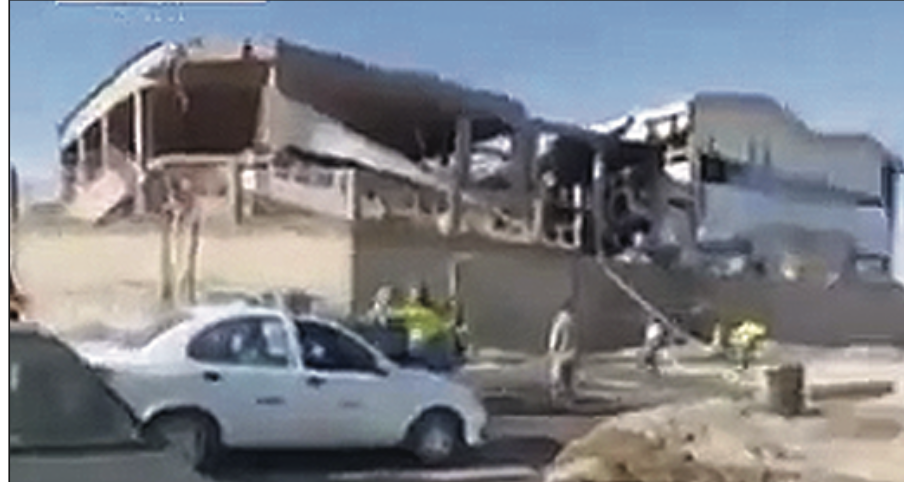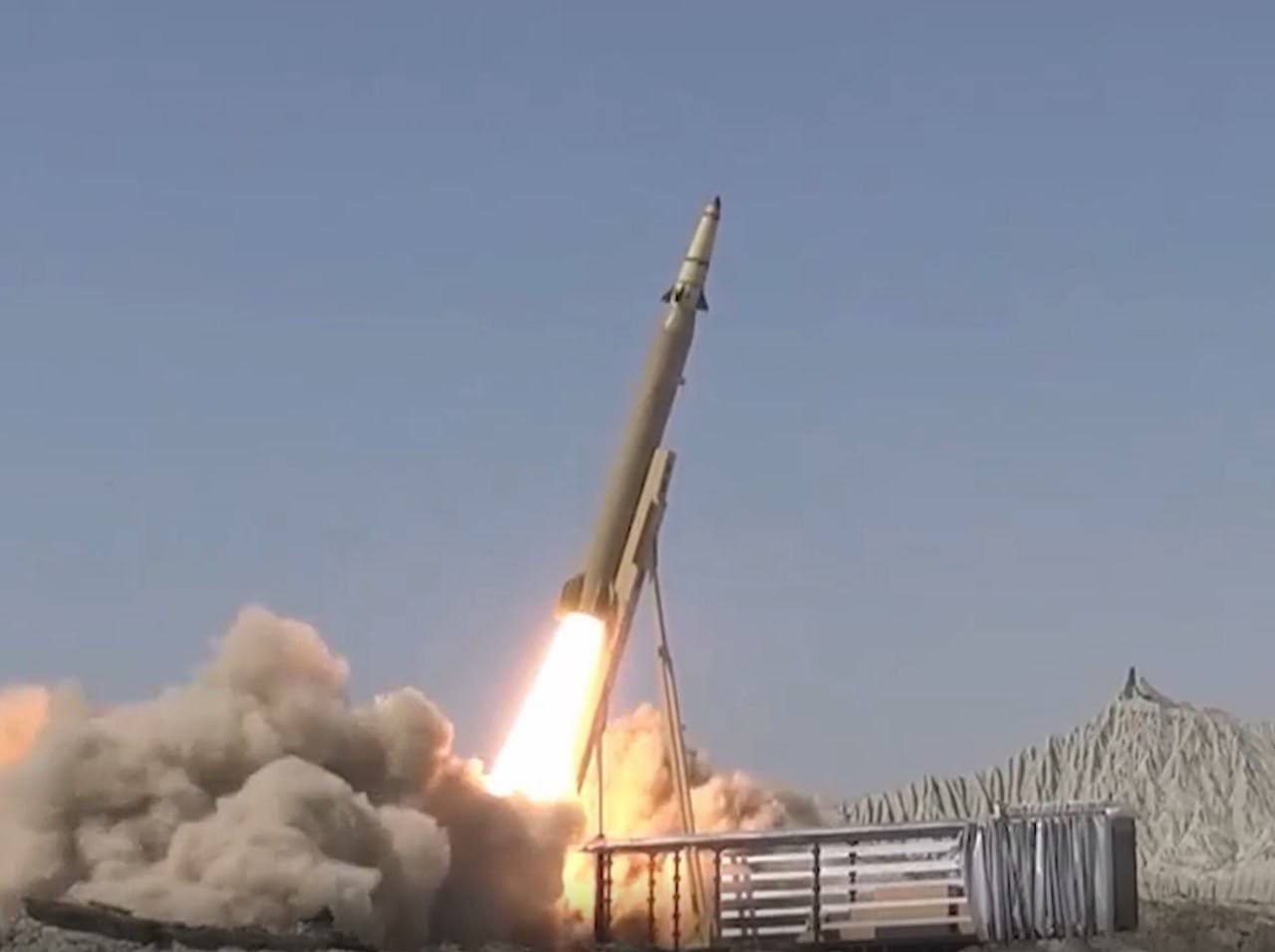October 28, 2024
by Warren L. Nelson
 After waiting 25 days, Israel retaliated October 26 with a missile attack on military sites scattered over three provinces of Iran. It was a modest air raid, compared to what had been widely anticipated.
After waiting 25 days, Israel retaliated October 26 with a missile attack on military sites scattered over three provinces of Iran. It was a modest air raid, compared to what had been widely anticipated.
The Islamic Republic avoided talking about damage on the ground, emphasizing instead that its highly-vaunted air defense system had “neutralized” the attack so there was only “minimal damage.”
Iran said Israel had attacked military bases in the provinces of Tehran, Ilam and Khuzestan. It said Iranian air defenses were able to reduce damage and claimed most incoming missiles had been shot down. It will be a major black eye for the Iranian military if few or no Israeli missiles were destroyed, since the military has claimed repeatedly that it dominates Iranian airspace and can stop any penetration and since Israel knocked down the majority of the 181 Iranian missiles it says were fired at Israel October 1
However, the regime has not shown off the detritus of even one Israeli missile shot down by Iran, leaving the appearance that the much-vaunted air defense was a complete failure.
Iran said four soldiers and one civilian were killed in the latest Israeli raid. The Fars news agency described the soldiers as missile operators. They were identified as Major Hamzeh Jahandideh, Major Sajjad Mansuri, Sergeant Mehdi Naqavi and Sergeant Mohammad-Mehdi Shahrokhifar. The reports did not say where they died. The civilian, Allahverdi Rahimpur, was described as a security guard at a contractor factory.
Israel said it struck 20 targets; Iran said the true number was “significantly” lower. Israel said it used 140 warplanes in three waves for the attack; Iran said that was a “complete lie, as Israel is seeking to overplay its weak attack.”
News reports in Iran cited citizens saying they heard sounds of explosions in Esfahan, Mashhad and Kurdistan provinces, none of which were attacked, according to the Iranian military. That suggests the regime was trying to further minimize what happened or that many jittery citizens were over-reacting to noises—most likely the latter.
The attacks began about 2:15 a.m. Tehran Time October 26 and Israel announced at 6 a.m. that they had been completed.
Based on the targets identified to date, it appears Israeli was primarily trying to stop Iran from stocking up on missiles able to reach Israel and to prove to Iran that its air defense system is useless and cannot really defend Iran from anything Israel decides to throw at it.
Israel struck at two buildings understood to contain the machinery used to mix the solid fuel that powers the long-range missiles that can reach Israel. It reportedly destroyed 12 such mixers that it got from China and will have to go to China for replacements.
It also attacked the four S-300 Russian-made air defense missile batteries that Iran bought almost two decades ago. They are the most sophisticated air defense systems Iran possesses. It isn’t yet known how much damage Israel did to those batteries.
Israel also targeted the building that housed the test equipment Iran used before 2003 to test the trigger mechanism it was working on to detonate a nuclear weapon. It isn’t known why Israel chose that target, as Iran is not believed to have done any further trigger work in the last 21 years.
The Islamic Republic News Agency (IRNA), the government’s official news agency, reported nothing for a long time after the attack began. The Tasnim news agency, perhaps responding to orders from the censor to play down any attack, reported, “According to some sources, the air defenses have fired missiles, but the situation in the capital is normal, including at Imam Khomeini and Mehrabad airports.”
The Mehr news agency reported, “In the early hours of Saturday, several explosions were heard in Tehran…. Reports suggest that some of the loud sounds were caused by the operation of air defense systems. The situation in the capital is calm and airports in Tehran are operating normally.”
Mohammad Marandi, a conservative political analyst close to the government, downplayed Israel’s attacks in an interview with Al Jazeera television, before the strikes were over. Marandi said Iran had been expecting much stronger attacks.
The general downplaying of the attacks suggested to many that the Islamic Republic may not want to respond and decided even before the attack was launched to minimize Israel’s action to justify taking no retaliation.
Supreme Leader Ali Khamenehi issued a statement condemning Israel’s attack. But, significantly, he did not say a word about any Iranian retaliation, suggesting to many that he wants to stop the tit-for-tat attacks before Iran gets seriously bloodied. But many hardliners were talking about nothing but flattening Israel.
Saudi Arabia and the UAE both denounced the “military targeting” of Iran. But, significantly, neither mentioned Israel in the statements. They were showing minimal support for Iran. They were refusing to rise to anything more than token defense of Iran and they were unwilling to confront Israel or even denounce it.
At the start of the attack, Israel’s military said it was conducting “precise strikes on military targets in Iran … right now.” It is the first time Israel has announced military actions against Iranian targets. It has attacked Iranian targets in Syria dozens of times and attacked an air defense missile site near Shiraz in April. It did not acknowledge those attacks. This time it announced the attacks while they were in progress.
In Tehran, cars were seen lining up at gasoline stations soon after the attack in fear that they would soon be without fuel. That also indicated that many Tehranis had no fear that Israel would bomb residential areas.
The Wall Street Journal reported that Iran got advance notice hours before the attack—a warning from Israel that was passed along by several Arab and European countries. It said the Israeli news reports said the first planes attacked air defense sites in Syria and Iraq before attacking military installations in Iran. They did not say if any of the warplanes entered Iranian airspace. In the April attack, Israeli warplanes fired missiles at Iran from Iraqi airspace. It is assumed that was the same modus operandi this time. Israeli warplanes do not have the range to fly far into Iran and return home without aerial refueling over Arab countries. Only one Israeli missile has the range to reach Iran from Israel, and it was designed to carry nuclear warheads and thus is assumed to have poor accuracy. The missiles Israel attacked with are launched from aircraft. Israel showed film of F-15s and F-16s taking off for the raid and announced that two pilots and two navigators in the planes were women. It said all the planes returned untouched. It did not say if any of the missiles they launched had been shot down.
Media around the world spent the weeks preceding the attack wringing their hands that an Israeli attack would lead to a huge regional war or even an outbreak of World War III. This was grossly overdrawn since Israel and Iran are more than 1,000 kilometers apart and neither has an army that can reach the other. They are essentially limited to missile exchanges.
After its ineffective attack on Israel October 1, the Islamic Republic tried to discourage a major Israeli retaliation by sending a message to Israel saying that it would ignore a token retaliation. The Saudi daily Asharq Al-Awsat reported October 11 that the Islamic Republic had sent a diplomatic message to Israel through the EU saying it would “shrug off a limited Israeli strike” but “would have no choice” but to retaliate if its oil or nuclear facilities were hit.
Then the Iranian military began making almost daily public announcements that in the event of a major Israeli retaliation it would hit Israel hard with punishing attacks. But there appeared to be some division in the ranks. President Pezeshkian said more than once that Iran would respond “proportionally” to any Israeli attack, while assorted generals ranted that Iran would respond with an attack mightier than what Israel launched against Iran.
Anticipating a swift Israeli response after its October 1 barrage, Iran closed all of its airports from 9 p.m. local time October 6 to 6 a.m. the next day. But oddly, it left the airports open after that despite the public Israeli announcements that it would retaliate. The closure was presumably to avoid a repeat of the 2020 deadly incident in which the Pasdaran shot down a Ukrainian passenger jet leaving Imam Khomeini International Airport after the regime had fired missiles at an Iraqi base used by the American military. Iran said a junior officer had mistaken the Ukrainian plane for an American Tomahawk missile.
Arab officials told reporters the Islamic Republic had threatened to attack Arab states if they allowed their airspace to be used by Israel to attack Iran. The Arab officials said the warnings went to Jordan, the UAE, Saudi Arabia and Qatar. But Israel doesn’t need to use those countries; in its April attack on Iran, it sent a warplane over Syria and Iraq, which have limited air defense capabilities, then fired two missiles from within Iraqi airspace at a Russian-made S-300 air defense missile site near Esfahan. The first missile took out the site and the Israelis than destroyed the second missile in mid-flight since it was no longer needed.
Israel waited 25 days after it was attacked October 1 before it retaliated. The delay was primarily because Israel’s government could not decide what targets to strike. Officials argued over whether to make a token attack, as it did after Iran struck Israel in April, or to launch a huge and very destructive attack. They argued over how much to listen to the Americans, with the Biden Administration saying Israel should not hit either nuclear or oil targets. They argued over what kind of targets to hit—naval, missile, Pasdar, refineries, electricity generating plants, air defense sites—and whether to try to destroy or just damage whatever they targeted.
In the end, they confined their actions to military sites. The Biden Administration appeared satisfied at the limited size of the retaliation. But many in Israel said it was too modest.
Iranian news media, meanwhile, have been filled almost daily with stories about “massive explosions” all across Israel, stemming from drones and rockets fired into Israel by Hezbollah and now also by the Iraqi militias that are backed by the Islamic Republic and that started sending drones against Israel after they were ordered by Iran to stop striking bases in Iraq used by US troops.
Periodic drones and rockets have indeed penetrated Israeli defenses, but none of them have hit anything of significance or caused “massive explosions.” They have started some forest fires and poked holes in streets, but not done much more. Reporters can’t go onto military bases to see what damage has been done there, but Israel has acknowledged the deaths of four soldiers to one drone attack from Hezbollah.
The United States has shown its continuing support for Israel against Iranian attacks by deploying to Israel on October 13 its highest technology air defense system, the Terminal High Altitude Area Defense (THAAD). The US also sent several dozen troops to operate the system. Iranian Foreign Minister Abbas Araqchi condemned the deployment and said it was “risking the lives” of American troops by doing so. That produced smirks, given that earlier this year one of the Iraqi militias backed by Iran fired a drone that killed three US soldiers stationed in Jordan. This is the third time the US has deployed THAAD in Israel on a temporary basis.
After the October 26 retaliation, the White House expressed support for Israel’s operation, calling it targeted and proportional, while expressing the belief that it should be the end of the direct military exchanges between Israel and Iran. An official who briefed reporters said the United States would again come to Israel’s defense if Iran chooses to retaliate.
Adopting the standard rhetoric of the Islamic Republic over the decades, Mohsen Rezai, former commander of the Pasdaran, described the Israeli attack as unsuccessful and weak. “The Zionist regime’s aggression against Iran was more a sign of fear and fright than it was a show of strength,” said Rezai, now a member of the Expediency Council, in a post on X.
First Vice President Mohammad-Reza Aref posted on social media, “Iran’s power humiliates the enemies of the motherland.”
Iranian state media bent over backward to portray the Israeli attacks as having limited impact. The Tasnim news agency said the Israeli attack “failed despite some minor damage it caused.” State television reported that the sounds of explosions around Tehran were caused by air defense systems, while Press TV showed people in Laleh Park doing their regular morning exercises hours after the attack and emphasizing that normality prevailed.

























